|
Notes: Oswestry station was the principal station and headquarters of the Cambrian Railways (CR) company. The CR was formed on 25 July 1864 when the Oswestry & Newtown Railway (O&NR), the Oswestry, Ellesmere & Whitchurch Railway (OE&WR), the Newtown & Machynlleth Railway (N&MR), and the Llanidloes and Newtown Railway (L&NR) companies merged.
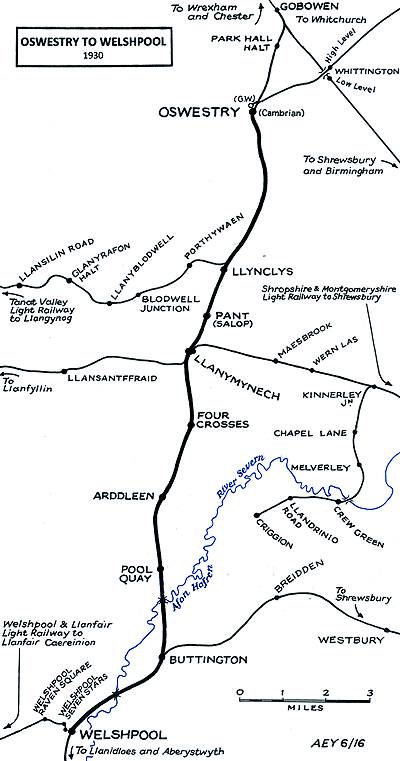 The station had opened on 1 May1860 as the eastern terminus of the O&NR. It was located on the eastern edge of the town just south-east of the Great Western Railway’s (GWR) station which had opened on 23 December 1848. At the time of opening the station consisted of a single platform, located on the west side of the line, towards the north end of which was located a small single-storey building that housed booking and waiting facilities. At this time the line extended only as far as Pool Quay from where an omnibus service provided a link with Welshpool. The O&NR line opened through to Welshpool on 14 August 1860 and through to Newtown on 10 June 1861. The station had opened on 1 May1860 as the eastern terminus of the O&NR. It was located on the eastern edge of the town just south-east of the Great Western Railway’s (GWR) station which had opened on 23 December 1848. At the time of opening the station consisted of a single platform, located on the west side of the line, towards the north end of which was located a small single-storey building that housed booking and waiting facilities. At this time the line extended only as far as Pool Quay from where an omnibus service provided a link with Welshpool. The O&NR line opened through to Welshpool on 14 August 1860 and through to Newtown on 10 June 1861.
After only three years Oswestry became a through station when the OE&WR opened the first section of its line between Oswestry and Ellesmere on 4 May 1863.
In 1862 the O&NR had relocated their headquarters from Welshpool to Oswestry. Plans were drawn up for a large station building that would be capable of housing the headquarters and work commenced in 1863.
The building was located on the station platform to the south of the original building. It was an enormous structure, particularly in relation to the small size of the town it served, where it is the largest Victorian building. It is of red brick construction, twenty bays in length with two tall storeys and a hipped roof extending to the two front projections of the building. Openings are round-headed with pronounced keystones. Midway along the platform elevation is a two-storey canted bay in ashlar; this material provides relief from the brick being used as quoins, architraves, eaves modillions and as panels along all four façades. A lean-to verandah extends between the front projections. An awning of this style formerly extended the entire length of the building on the platform elevation. This description is derived from Biddle (2003).
Oswestry also had goods facilities, including a large, stone-built goods shed, at the south end of the passenger station.
In 1865 the Aberystwyth & Welsh Coast Railway amalgamated with the CR which meant that by 1866 they had a main line between Whitchurch to Aberystwyth. The CR needed a locomotive works and as Oswestry was their headquarters they decided to build it there. Land was chosen to the north of the station on the east side of the line and the works, costing £28,000, opened in August 1866 (Click here to read more).
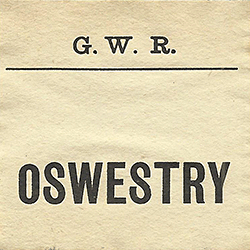 In 1893 the CR added a platform to the east of the original. It became the down platform (Newtown direction) and the original became the up (Whitchurch direction). Additional facilities were provided on the down platform in a building almost as large as the 1863 structure, and clearly design to complement it. The 1893 building was also of brick construction, with a hipped roof and round-headed openings. However, unlike the roofing on the down platform, the up platform was sheltered by an awning of ridged profile and it did not stretch the full length of the building behind it. Together the old and new buildings made a handsome and imposing pair. In 1893 the CR added a platform to the east of the original. It became the down platform (Newtown direction) and the original became the up (Whitchurch direction). Additional facilities were provided on the down platform in a building almost as large as the 1863 structure, and clearly design to complement it. The 1893 building was also of brick construction, with a hipped roof and round-headed openings. However, unlike the roofing on the down platform, the up platform was sheltered by an awning of ridged profile and it did not stretch the full length of the building behind it. Together the old and new buildings made a handsome and imposing pair.
A covered footbridge was provided at the north end of the station.
Goods facilities were also improved through the provision of a new yard at the rear of the down platform.
Two signal boxes were provided to control the traffic movements through the station. To the south of the up platform adjacent to the goods yard was Oswestry South box and to the north of the station also on the up side of the line, opposite the southern end of the Cambrian works, was Oswestry North box.
At 8.03pm on 19 December 1900 there was an accident at Oswestry station involving a mixed passenger/goods train and a brake van attached to an empty coach which had been left on the up main line. The brake and coach had been detached from a goods train that had arrived earlier so that it could shunt some wagons. The driver of the mixed train had passed signals set at danger and was therefore blamed for the crash.
On 1 January 1922 the CR was absorbed into the GWR. The GWR made Oswestry the headquarters of their West Wales Division.
The GWR did not want to operate two passenger stations at Oswestry so decided to close their 1848 station. In order to do so they extended the up platform of the former Cambrian station at its north end and made a bay on its western side. The extension of the platform involved demolishing a goods shed and Oswestry North signal box. A new signal box was opened at Oswestry North Junction (Click here to read more) which had been remodelled as part of the works.
The platform extension and bay were completed by 7 July 1924 when all trains that previously used the 1848 station were switched to the former Cambrian facility. Most of those trains were shuttle services to and from Gobowen on the GWR’s Birmingham – Birkenhead main line; the shuttles mostly used the new bay platform.
The GWR continued to serve a variety of destinations in mid-Wales and they operated an intensive shuttle service to and from Gobowen. They also ran through services from Oswestry to Birkenhead, Crewe and Manchester.
 |
At nationalisation on 1 January 1948 the former GWR lines (with the exception of some joint lines) became British Railways Western Region: BR[WR]. By 1957 Oswestry station had been fitted with WR totem nameplates of the half-flanged style. However on 1 January 1963 Oswestry was transferred to British Railways [London Midland Region] (BR[LMR]). In the same year the Reshaping of British Railways Report (the Beeching Report) was published. It recommended the withdrawal of passenger services between Welshpool and Whitchurch including the Llanfyllin branch. The last trains ran on Sunday 17 January 1965 and services on the main line ended on 18 January 1965. Interestingly the Oswestry – Gobowen line had not featured in the report and as a result that service continued to run. However on 25 August 1965 a proposal was published to withdraw the Gobowen service. At that time there were still 21 trains in each direction.
On 27 January 1966 the hearing of objections concluded and on 7 July 1966 the Minister of Transport, Barbara Castle. approved the withdrawal of the service. The last trains ran on Saturday 5 November 1966 and Oswestry station closed to passengers on 7 November 1966.
 The line to Ellesmere had closed completely after the last trains ran and it was lifted shortly after. This left only the former GWR branch to Gobowen as a connection to the national network. South of Oswestry the main line remained open as far as Llynclys Junction so that stone trains could reach the quarry at Blodwell. General goods services continued to run to Oswestry until December 1971. The line to Ellesmere had closed completely after the last trains ran and it was lifted shortly after. This left only the former GWR branch to Gobowen as a connection to the national network. South of Oswestry the main line remained open as far as Llynclys Junction so that stone trains could reach the quarry at Blodwell. General goods services continued to run to Oswestry until December 1971.
In 1972 track-lifting began at Oswestry and by 1974 there was only a single track left running through the station. The down platform building was demolished in the latter part of 1972.
In 1972 the Cambrian Railways Society was formed. They took out a lease on the station goods yard and goods shed and created a museum. Trains to Blodwell ceased in 1988 and the society looked at creating a heritage line but progress proved to be difficult.
In the years following closure the Oswestry station building fell into a state of dereliction. In 2005 it was purchased by Oswestry Borough Council who renovated it, creating a restaurant and visitor centre on the ground floor with offices on the first floor. The building was leased to the Oswestry Station Building Trust, a charity set up for the purpose.
In 2009 the Cambrian Railway Society merged with the Cambrian Railways Trust to form Cambrian Heritage Railways and in the years following progress was made at Oswestry station. By September 2016 the up platform had been restored and work had begun on the down platform.
To read about passenger train services at Oswestry click here
Ticket from Michael Stewart and route map by Alan Young
Sources:
- A Regional History of the Railways of Great Britain - Volume II North & Mid Wales - Peter E Baughan - David & Charles 1980.
- Encyclopaedia of British Railway Companies - Christopher Awdry - Guild Publishing 1990.
- Railway Passenger Stations in Great Britain - A Chronology - Michael Quick - Railway & Canal Historical Society 2009.
To see other stations on the Whitchurch - Welshpool line click on the station name: Whitchurch STILL OPEN, Fenn's Bank, Bettisfield, Welshampton,
Ellesmere, Frankton, Whittington High Level, Tinkers Green Halt,
Llynclys, Pant (Salop), Llanymynech, Four Crosses, Arddleen Halt,
Pool Quay, Buttington, Welshpool 1st, Forden, Montgomery and Abermule
See also Oswestry (GWR) and Park
Hall Halt on the Oswestry - Gobowen line
See Also: Oswestry Locomotive Depot, Oswestry North Junction
and Cambrian Locomotive Works |

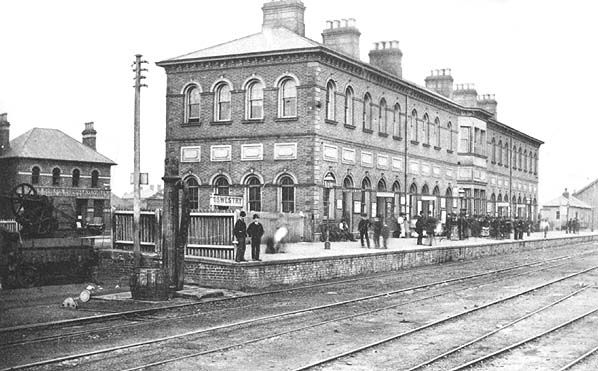
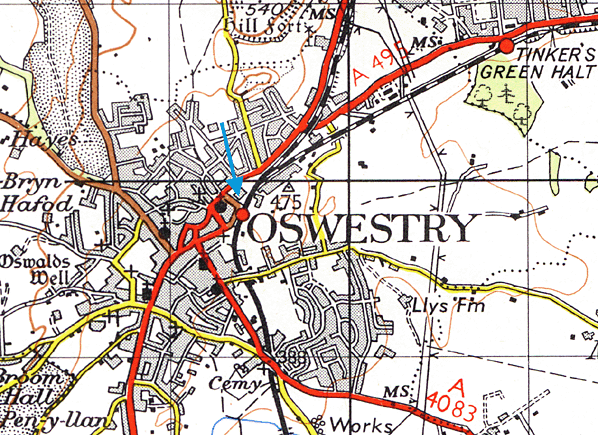
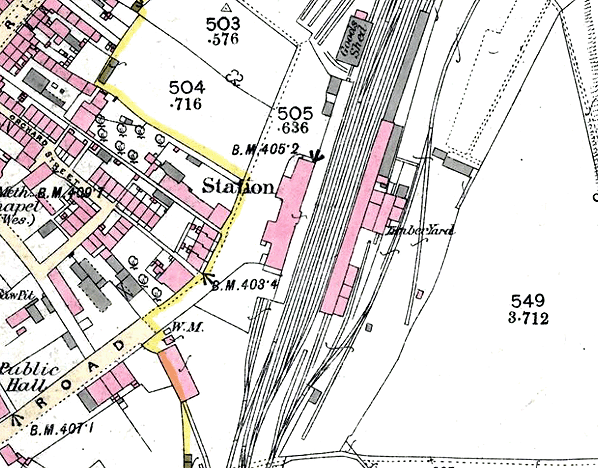 The Oswestry Cambrian Railway station shown on a 1:2,500 scale map from 1874. At that time there was only one platform which was located on the west side of the line. A large station building had been built in 1866 which also acted as the Cambrian Railway headquarters.
The Oswestry Cambrian Railway station shown on a 1:2,500 scale map from 1874. At that time there was only one platform which was located on the west side of the line. A large station building had been built in 1866 which also acted as the Cambrian Railway headquarters.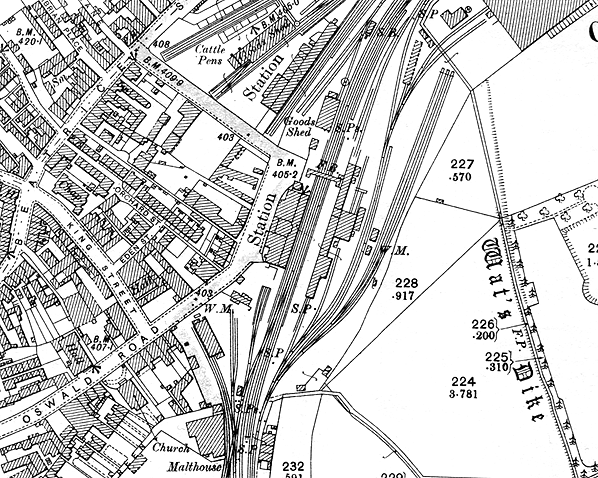
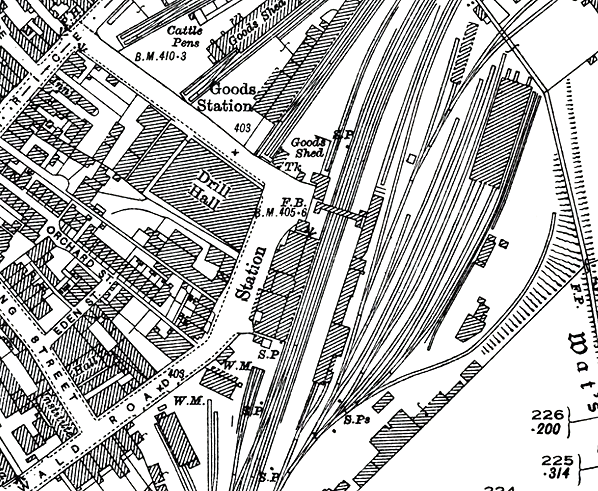 Oswestry station shown on a 1:2,500 scale map from 1924. The map shows the station after the GWR had taken over and made alterations and improvements. The up platform had been extended for some considerable distance in order to accommodate a bay for the Gobowen services.
Oswestry station shown on a 1:2,500 scale map from 1924. The map shows the station after the GWR had taken over and made alterations and improvements. The up platform had been extended for some considerable distance in order to accommodate a bay for the Gobowen services.9.jpg)
old19.jpg) Oswestry
station looking south-west from the north-eastern end of the up platform in February 1948. To the right a train can be seen in the bay platform which was built in 1924 when the up platform was extended. From 7 July 1924 the bay platform was used by trains running to and from Gobowen after the former GWR station closed to passengers.
Oswestry
station looking south-west from the north-eastern end of the up platform in February 1948. To the right a train can be seen in the bay platform which was built in 1924 when the up platform was extended. From 7 July 1924 the bay platform was used by trains running to and from Gobowen after the former GWR station closed to passengers.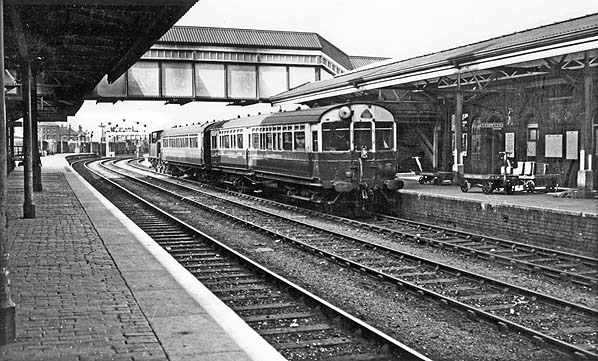
old30.jpg)
4.jpg)
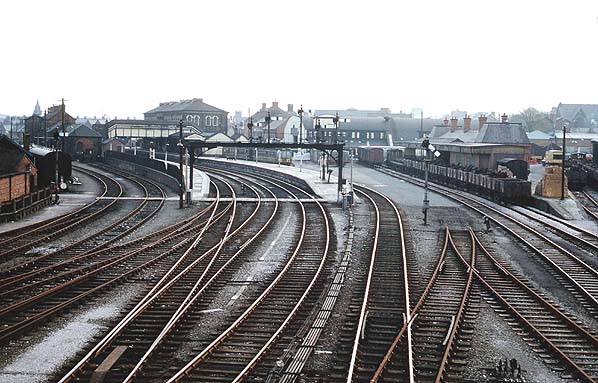 Oswestry station seen looking south-west on 23 April 1966. At this time the only passenger service was the shuttle that ran to and from Gobowen. A Gobowen service can be seen in the bay platform. Also of interest is the former Oswestry GWR station which is seen to the right.
Oswestry station seen looking south-west on 23 April 1966. At this time the only passenger service was the shuttle that ran to and from Gobowen. A Gobowen service can be seen in the bay platform. Also of interest is the former Oswestry GWR station which is seen to the right..jpg) Looking north-east at Oswestry station on 17 September 2016.
Looking north-east at Oswestry station on 17 September 2016. Home
Page
Home
Page

 The station had opened on 1 May1860 as the eastern terminus of the O&NR. It was located on the eastern edge of the town just south-east of the Great Western Railway’s (GWR) station which had opened on 23 December 1848. At the time of opening the station consisted of a single platform, located on the west side of the line, towards the north end of which was located a small single-storey building that housed booking and waiting facilities. At this time the line extended only as far as Pool Quay from where an omnibus service provided a link with Welshpool. The O&NR line opened through to Welshpool on 14 August 1860 and through to Newtown on 10 June 1861.
The station had opened on 1 May1860 as the eastern terminus of the O&NR. It was located on the eastern edge of the town just south-east of the Great Western Railway’s (GWR) station which had opened on 23 December 1848. At the time of opening the station consisted of a single platform, located on the west side of the line, towards the north end of which was located a small single-storey building that housed booking and waiting facilities. At this time the line extended only as far as Pool Quay from where an omnibus service provided a link with Welshpool. The O&NR line opened through to Welshpool on 14 August 1860 and through to Newtown on 10 June 1861.  In 1893 the CR added a platform to the east of the original. It became the down platform (Newtown direction) and the original became the up (Whitchurch direction). Additional facilities were provided on the down platform in a building almost as large as the 1863 structure, and clearly design to complement it. The 1893 building was also of brick construction, with a hipped roof and round-headed openings. However, unlike the roofing on the down platform, the up platform was sheltered by an awning of ridged profile and it did not stretch the full length of the building behind it. Together the old and new buildings made a handsome and imposing pair.
In 1893 the CR added a platform to the east of the original. It became the down platform (Newtown direction) and the original became the up (Whitchurch direction). Additional facilities were provided on the down platform in a building almost as large as the 1863 structure, and clearly design to complement it. The 1893 building was also of brick construction, with a hipped roof and round-headed openings. However, unlike the roofing on the down platform, the up platform was sheltered by an awning of ridged profile and it did not stretch the full length of the building behind it. Together the old and new buildings made a handsome and imposing pair.
 The line to Ellesmere had closed completely after the last trains ran and it was lifted shortly after. This left only the former GWR branch to Gobowen as a connection to the national network. South of Oswestry the main line remained open as far as Llynclys Junction so that stone trains could reach the quarry at Blodwell. General goods services continued to run to Oswestry until December 1971.
The line to Ellesmere had closed completely after the last trains ran and it was lifted shortly after. This left only the former GWR branch to Gobowen as a connection to the national network. South of Oswestry the main line remained open as far as Llynclys Junction so that stone trains could reach the quarry at Blodwell. General goods services continued to run to Oswestry until December 1971. 